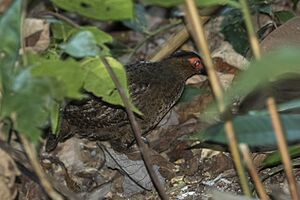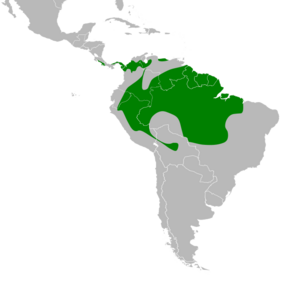Marbled wood quail facts for kids
Quick facts for kids Marbled wood quail |
|
|---|---|
 |
|
| Conservation status | |
| Scientific classification | |
| Genus: |
Odontophorus (bird)
|
| Species: |
gujanensis
|
 |
|
The marbled wood quail (Odontophorus gujanensis) is a type of bird in the New World quail family. It is also known as the Amazonian wood quail. This bird lives across a large area in Central America and the northern part of South America. You can find it in warm, wet lowland forests.
Contents
Naming the Marbled Wood Quail
The marbled wood quail was first officially described in 1789. A German scientist named Johann Friedrich Gmelin gave it its first scientific name. He put it in the group of birds called Tetrao.
Later, in 1816, a French bird expert named Louis Pierre Vieillot placed it in a new group called Odontophorus. The name Odontophorus comes from Ancient Greek words meaning "bearing teeth." This refers to a tooth-like shape on their bills. The second part of its name, gujanensis, means "from the Guianas," which is a region in South America.
There are eight different types, or subspecies, of the marbled wood quail. These different types live in various parts of its wide range.
- O. g. castigatus Bangs, 1901 – Lives in southwest Costa Rica and northwest Panama.
- O. g. marmoratus (Gould, 1843) – Found in east Panama, north Colombia, and northwest Venezuela.
- O. g. medius Chapman, 1929 – Lives in south Venezuela and northwest Brazil.
- O. g. gujanensis (Gmelin, JF, 1789) – Found in southeast Venezuela, the Guianas, Brazil, and northern Paraguay.
- O. g. buckleyi Chubb, C, 1919 – Lives in south and east Colombia, east Ecuador, and north Peru.
- O. g. rufogularis Blake, 1959 – Found in northeast Peru.
- O. g. pachyrhynchus Tschudi, 1844 – Lives in east-central Peru and west Bolivia.
- O. g. simonsi Chubb, C, 1919 – Found in north and east Bolivia.
What Does It Look Like?
Adult marbled wood quails are about 23 to 29 centimeters (9 to 11 inches) long. They have a strong, dark beak and bluish-grey legs and feet. Their eyes are brown, and they have bare orange or red skin around their eyes.
Both male and female quails look very similar. The front of their head and cheeks are reddish-brown. The feathers on top of their head are dark brown with wavy patterns. These feathers can be ruffled to form a short, loose crest.
Their neck and upper back are greyish-brown. Their back and wings are brown with black wavy patterns. The lower back and upper tail feathers have faint lighter spots. Their belly is a dull brown with some light and dark brown bars that are not very clear.
Young quails look similar to adults. However, their beaks are reddish-orange. Also, their reddish-brown crests do not have the wavy patterns seen in adults.
Where Do They Live?
The marbled wood quail lives in a wide area. This includes Central America and the northern part of South America. Its range stretches from Costa Rica and Panama, all the way to Colombia, Venezuela, Peru, the Guianas, and Brazil. Sadly, it is thought to be extinct in parts of Costa Rica and Panama.
This bird mostly stays on the ground. It prefers to live in the thick undergrowth of lowland rainforests and cloud forests. You can find them at different heights, up to 900 meters (2,950 feet) in Ecuador. In Colombia and Venezuela, they can live as high as 1,500 meters (4,900 feet).
Behavior and Life Cycle
The marbled wood quail is a shy bird. It usually moves quietly through the dense plants on the forest floor. Because of this, it is rarely seen. However, you can often hear its special calls, especially in the early morning and at dusk.
Sometimes, it will come out into open areas. But it always stays close to fallen trees or bushes. This allows it to quickly hide if it senses danger. If disturbed, it usually walks away quietly. But if it needs to, it can suddenly fly away.
These quails typically live in small groups. They walk in a single line, searching through the leaf litter on the ground. They look for small invertebrates (like insects) and fallen fruits to eat.
They build their nests at the bottom of a tree. The nest is a shallow dip in the ground, hidden under a roof of dead leaves. Females usually lay about four white eggs, which sometimes have brown spots. The time of year they breed depends on where they live.
Why They Need Our Help
The number of marbled wood quails is decreasing. This is mainly because their forest home in the Amazon basin is being cut down. Forests are cleared to make space for cattle to graze and for growing crops like Soybeans.
These birds can adapt a little to living in forests that have grown back after being cut down. However, more roads are being built in these areas. This makes it easier for people to hunt the quails.
The International Union for Conservation of Nature (IUCN) is a group that studies wildlife. They believe the quail population might drop by 25 to 30% over the next three generations of birds. Because of these threats, the marbled wood quail is now considered "near threatened". This means they are not in immediate danger, but they could become so if things do not change.


